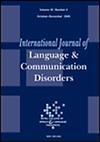Development and Real-Time Clinical Application of New Transcription-Less Discourse Assessment Approaches for Arabic Speakers With Aphasia
Abstract
Background
Assessing spoken discourse during aphasia clinical examination is crucial for diagnostic and rehabilitation purposes. Recent approaches have been developed to quantify content word fluency (CWF) and informativeness of spoken discourse without the need to perform time-consuming transcription and coding. However, the accuracy of these approaches has not been examined in real-time clinical settings, and they have been developed and validated mainly in English and thus cannot be applied to other languages.
Aims
For the first time: (i) to create and validate CWF checklists and main concept (MC) lists in Arabic; (ii) to examine the application of these two approaches in real-time clinical settings with people with aphasia (PWA) while they are performing the task; and (iii) to investigate whether these two approaches can differentiate discourse responses produced by PWA versus neurotypical adults.
Methods
The Arabic Discourse Assessment Tool (ADAT) was used to collect discourse responses on three tasks (composite picture description, storytelling narrative, and procedural discourse) from 70 neurotypical control adults and 50 PWA matched to the control group in age and education. The discourse samples were transcribed, and analysed. For each task, CWF checklists and MC lists were developed and validated using discourse reponses from the control group. Afterwards, the application of these two approaches in real-time clinical settings was examined with the aphasia groups. The psychometric properties of CWF and MC approches were examined.
Results
Novel Arabic CWF checklists and MC lists were successfully developed, validated, and applied clinically for three discourse tasks. The analysis showed significant high accuracy between CWF scores obtained in real-time clinical settings and those identified using the traditional approach of transcribing and analysing discourse samples across all three discourse tasks (ICC = 0.88 to 0.94). Furthermore, significant excellent reliability (ICC = 0.917 to 0.994) were found for the three tasks in both groups. Most of the MCs were produced accurately and completely by neurotypical control adults, whereas they were mostly absent in PWA. CWF checklists and MC lists showed significant high validity in distinguishing spoken discourse produced by PWA from those produced by neurotypical adults at p < 0.001.
Conclusions
This is the first study to develop and validate novel Arabic CWF checklists and MC lists. Furthermore, this study demonstrated that the CWF approach and main concept analysis (MCA) can be applied clinically in real-time with PWA. These transcription-less approaches can be used as part of the routine aphasia clinical examination to provide quick but accurate assessments of CWF (microlinguistics) and informativeness (macrolinguistics) of spoken discourse in PWA. These approaches also provide a significant resource for Arabic speakers with aphasia, that will lead to accurate aphasia assessments and better clinical management.
WHAT THIS PAPER ADDS
- Conversations between people rely heavily on producing relevant and informative spoken discourse. Thus, there has been increased interest in the application of discourse tasks in clinical practice to enable a comprehensive assessment of expressive language and functional communication. However, utilising discourse tasks in clinical settings is impractical because their administration and scoring are time-consuming, labour-heavy, and must be completed after the session has ended. Therefore, transcription-less, efficient, and accurate approaches to analyse discourse responses have been developed and validated in English. However, no study has investigated the application of these approaches in real-time clinical settings with people with aphasia (PWA).
- To our knowledge, this is the first study to (i) develop and validate content word fluency (CWF) checklists and main concept (MC) lists in Arabic. These were created for three discourse tasks (composite picture description, storytelling narratives, and procedural discourse) using discourse responses from a neurotypical control group; and (ii) examine the application of these valid, transcription-less, efficient, and accurate approaches to assess CWF and informativeness of spoken discourse in PWA in real-time clinical settings.
- The transcription-less, efficient, and accurate discourse assessment approaches that have been developed and validated in this study allow clinicians to objectively assess discourse responses produced by Arabic speakers with aphasia during clinical examinations while the person is speaking without the need for offline transcription, analyses, and scoring. The reliable application of these approaches in real-time clinical settings encourages clinicians to incorporate discourse tasks as part of their routine clinical examination with PWA to be used (i) for a comprehensive assessment of expressive language skills beyond words and sentences, (ii) to guide the development of personalised therapy goals and strategies to improve functional communication, and (iii) as outcome measurements to monitor spontaneous recovery and changes in response to interventions.


 求助内容:
求助内容: 应助结果提醒方式:
应助结果提醒方式:


